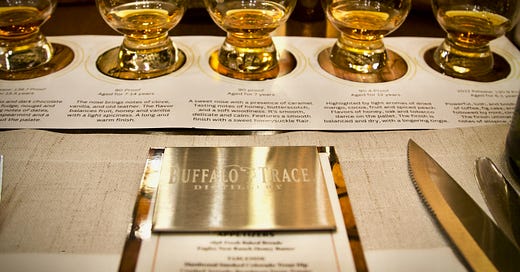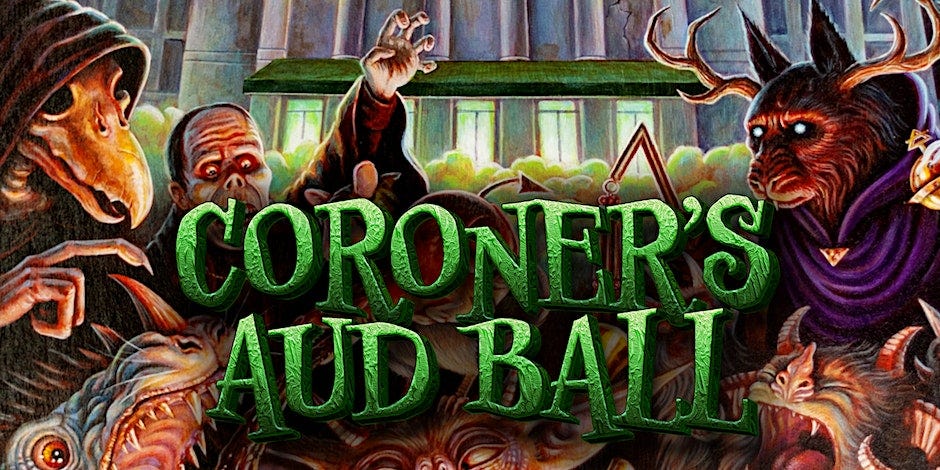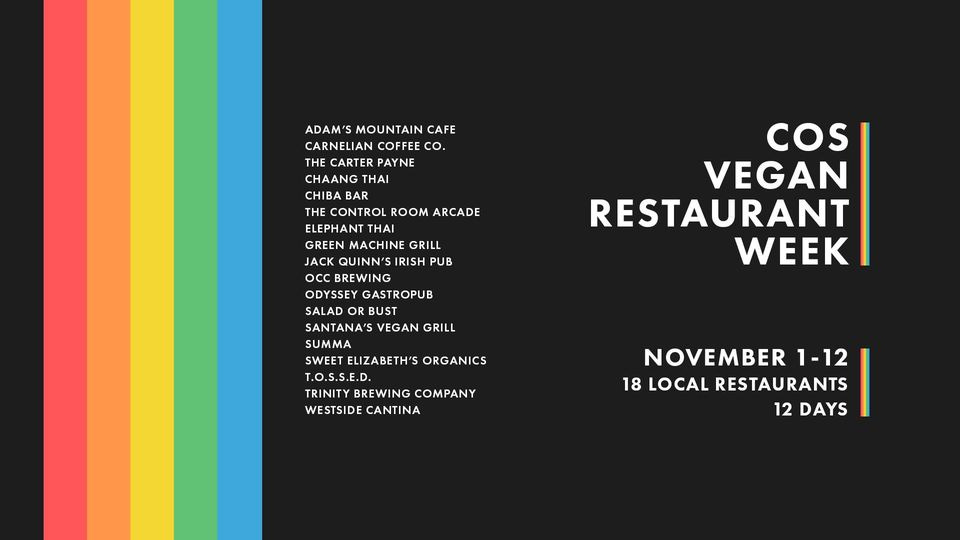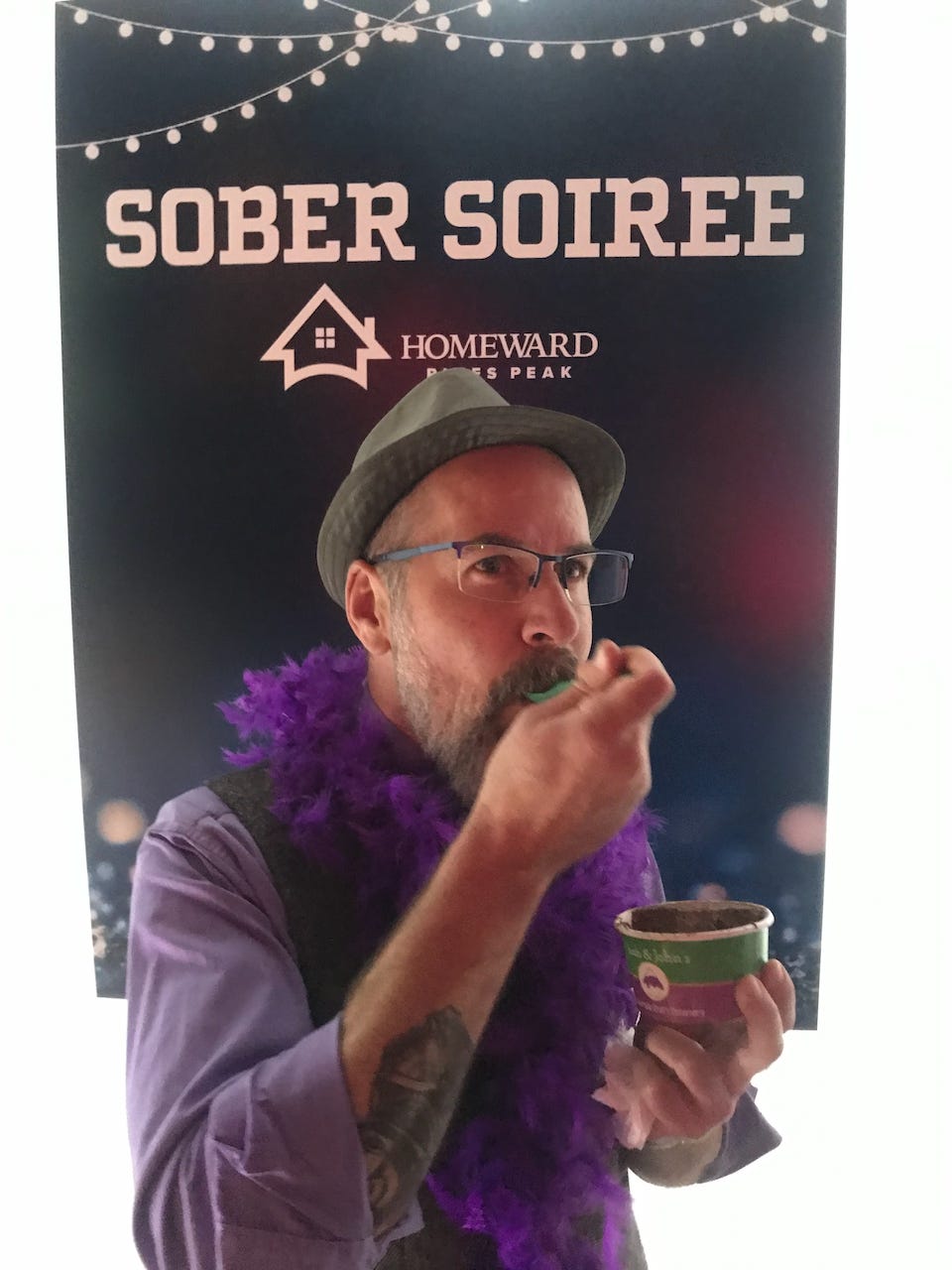"The sum is better than the individual parts"
Sazerac's Master Blender talks whiskey business, marshmallow matcha at a new coffee cart, Halloween happenings + more food & drink news

“I hope you enjoyed it, because you’re never going to get these whiskies again.”
That’s what one of my dining mates at the Buffalo Trace Distillery Meet the Maker whiskey dinner series at The Broadmoor’s Restaurant 1858 at Seven Falls said after our meal on Oct. 24. He wasn’t really joking, despite our laughter, because procuring something like a bottle of Van Winkle Special Reserve 12 Year will easily set you back around $1,000 in the online resale market. And that was only one of the five whiskies we got to taste under the guidance of Sazerac Master Blender & Director of Quality Drew Mayville during the lavish evening.
Yes, it was a hella expensive seat (for which I was graciously comped as media, by way of transparency), but in one of those if-you-know-you-know kind of ways, access to samplings of these highly allocated (meaning incredibly limited, coveted and collected) whiskies carries a justifiable cost. That’s before the fine food menu’s even considered. And not everyone gets to jam their nose inside a Glencairn glass alongside a famous (in the whiskey world) master blender of Mayville’s status. That’s the kind of special experience the Broadmoor creates. I’ve met some heavy hitters in the food and drink industry over my past many years of attendance at the hotel’s events. (Makes sense: Five Stars, Five Diamonds and all.)
Anyway, for this lead item this week, I’m not going to do a play-by-play of the amazing meal and whiskey tasting, belaboring nerdy tasting notes. Instead, I’m going to give a snapshot of some bites and the dinner’s ambiance and a quick list of the rare whiskies. And I’m going to excerpt from my 45-minute exclusive interview with Mayville to get into the mind of a master blender whose tastes help dictate the final flavors of some of the most celebrated whiskey labels in the world.
Final setup note: This post is partly in collaboration with my good buddy Mike Frey who’s the content creator of the respected, Indianapolis-based whiskey blog The Bourbon Culture. Frey and I first met around a decade ago when he was stationed in the Springs with the Army, doing supply and logistics work. He got my attention as an amateur (but quite savvy) food critic posting a prolific amount of online reviews. “Who the hell is this guy?” I remember asking my colleague Bryce Crawford, before we made contact and met him for lunch. I want to thank Frey for creating a thorough one-sheet for me that outlined the background of each featured whiskey with incredible depth of knowledge. As well, he wrote a short list of questions from the hardcore whiskey enthusiasts’ perspective that I tossed out to Mayville on his behalf during the second part of my interview. Frey will publish his own article soon with his edited excerpts that he finds most interesting. (I’ll update this post with a link.) Meanwhile, check out Frey’s recent writeup on Mister Sam (Batch 3, 2023), what he refers to as Drew Mayville’s “baby” and a whiskey he regards as “one of the single greatest American Whiskies to be released in the last 5 years.”
The whiskey list, and some of Mike Frey’s insight on each:
• George T. Stagg Kentucky Straight Bourbon Whiskey (2022 release, aged 15.5 years; 138.7 proof). “Out of all the bourbons you’ll be drinking tonight, this one is my favorite… Because it’s so much older than their typical bourbon, it will have mellowed out a lot in the barrel. Therefore, it shouldn’t taste as hot as you’re thinking it’ll taste.”
• Elmer T. Lee Single Barrel (aged 7-14 years, 90 proof). “Technically, it’s not a full Buffalo Trace product. It’s owned by a company called Age International (which is owned by the Japanese). They use their own mash bill, referred to as Buffalo Trace Mash Bill #2… It’s evolved into more of a partnership today where the two have the look and feel of one company.”
• W.L. Weller Special Reserve Kentucky Straight Bourbon Whiskey (aged 7 years; 90 proof). “It’s generally believed to be a blend of 5- to 7-year old barrels of the wheated bourbon mash bill... Weller Special Reserve’s main competitor is Maker’s Mark Bourbon, which is similar in age and proof.”
• Van Winkle 12 year Kentucky Straight Bourbon Whiskey (90.4 proof). “There are five varieties of Van Winkle Bourbon: a 10 year, 12 year, 15 year, 20 year and 23 year. It is universally recognized by enthusiasts that the 15 year is the best of them all. But it’s still cool you get to try this.”
• Thomas H. Handy Straight Rye Whiskey (2022 release, aged 6.3 years, 130.9 proof). “The recipe they use is commonly known as a ‘barely legal’ rye, which sounds kind of funny, but denotes the fact that the minimum rye used in the mash bill to be called a straight rye whiskey is 51 percent. It’s theorized that Buffalo Trace doesn’t use any more than that either.”
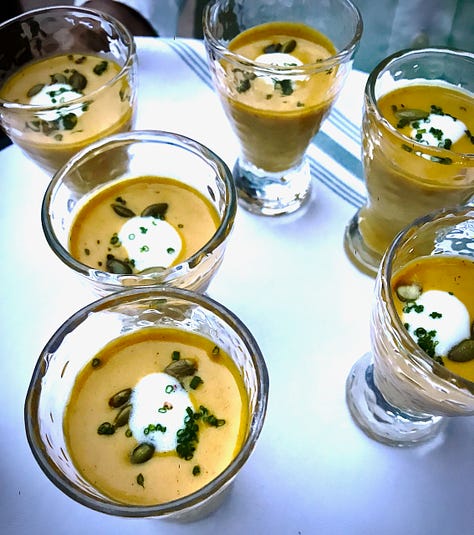
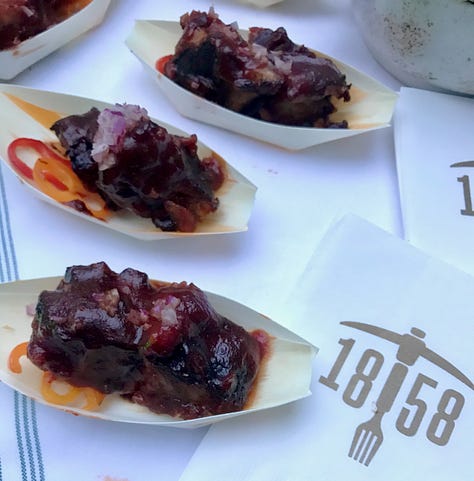
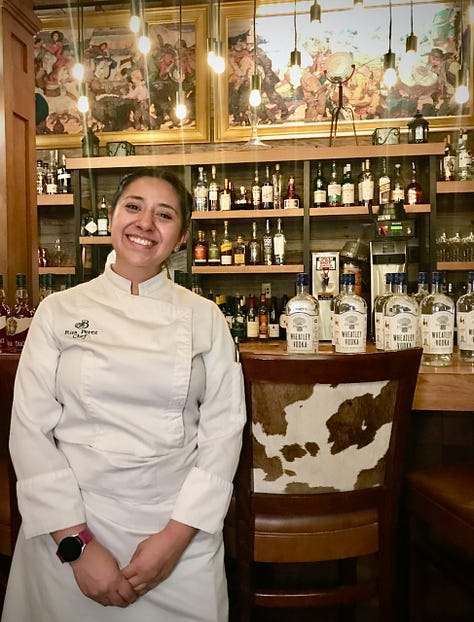






My Q&A with Drew Mayville (edited for clarity and conciseness):
Schniper: What is the art of blending? How do you do what you do?
Mayville: It’s like my mentor Art Dawe always said to me, ‘the sum is better than the individual parts.’ I describe it as like a symphony. I used to play the clarinet and was pretty lousy at it, but when you put it together with everybody else it turned out pretty good. You can make something so unique by blending different products together such that you can't replicate it any other way…. Bourbon is always mixing the same things… we take all these individual components, even though they're the same mash bill, from different parts of the distillery and we put them together to make the final product. We don't actually call it ‘blending’ in the industry; we call it ‘mingling’ — but I don’t want to be called the ‘master mingler’… Blending is to ensure the consistency of a product… Seagram’s [where Mayville got his start and worked for over 20 years] was the best in the industry at the time and they were the largest distiller in the world… they were a great training ground for blending. Sam Bronfman was one of the first in the industry to start blending whiskies, and he got it all from Scotland and Ireland. He brought back that knowledge — we were so advanced into blending you wouldn't believe. We used to inter-plant ship all those components from each distillery across Canada and put the blends together; it was really sophisticated. Today we don’t do that. It’s much easier. Now we have one plant.
Schniper: How do you clear your palate between samplings so you can always be at your top of tasting?
Mayville: That’s a really good question because it's unique to everybody — everybody's different. So we have a panel of almost 40 people. We look at lots of samples at once… up to a couple hundred samples a day. So some people will just take a break. Some people like water to reset. I like just getting away and coming back, because it's in our office, in my labs, I can go back and forth… in the morning is the best time for me and probably most people, as opposed to later because you start exhausting your senses. But we also look at progressive flavors. So we'll go from the lightest to the heaviest. Fireball is always at the end. [To clarify: Mayville technically works for Sazerac, which owns Buffalo Trace. He doesn’t just taste whiskies, but also vodkas, rum, cognac, flavored spirits, etc.]

Schniper: You mentioned at the dinner that wheat was introduced into bourbon’s grain bill around 100 years ago by W.L. Weller [who employed as a salesman Julian P. Van Winkle, Sr., known as “Pappy”]. Wheated bourbons are today traditional and familiar. Do you think we’ll see another great whiskey leap forward with something else disruptive that could re-define whiskey for a new era?
Mayville: Yes, it’s happened. We have innovation excellence that we’ve been practicing for the last 20 years I’ve been here. It’s phenomenal what we’ve been doing… We did an experiment with four grains: we talked about corn, wheat, rye and barley malt. We made a bourbon with all four, still majority corn [which is partly what defines a bourbon, being at least 51-percent corn]. And that turned out to be Best Whiskey in the World by Jim Murray. [Murray produces Jim Murray’s Whiskey Bible; the spirit he’s referencing is E.H. Taylor, Jr. Four Grain released in 2018.] … We have done experiments with lots of other things, and that’s just the tip of the iceberg… We have a building that we call our Warehouse P. It lowers the temperature to 40-something degrees. And we're finding some amazing things I can't talk about. The idea is that maybe we’ll make a better bourbon if we do it this way, aged longer. We’re always looking for ways to make a better whiskey. So instead of Pappy Van Winkle 23 being almost the maximum you can age a product in a new barrel in Kentucky, maybe it'll be 50 or 100 years. But I won’t be around to figure it out. [Mayville explains that if you age a Pappy barrel for 23 years in the wrong location it’ll run dry because of the heat. 53 gallons go into a barrel and after 23 years about six to 10 gallons come out. “So it’s really concentrating that flavor.” In the industry, they call this evaporation “the angels’ share.”]… We’ve also built a mini warehouse called Warehouse X; it cost over a million dollars and we're experimenting with different warehouse variables. It's got five chambers and you can control all the variables like air flow, temperature and humidity. We're playing with the variables to see what that does. [Their first test in Warehouse X was to try to replicate the conditions of when a tornado tore the roof off of Warehouse C in 2006, exposing the barrels to the elements for five months while re-construction was underway. They bottled that whiskey and called it E.H. Taylor, Jr. Warehouse C Tornado Surviving. “There’s people that swear it’s the best whiskey they’ve ever tasted,” he says. A quick look online shows it selling in the aftermarket for as high as $10,000-$15,000 a bottle.]
Schniper: What’s your take on widely available commercial products vs. highly allocated ones, such that there’s this expensive aftermarket that makes the most special/rare products exclusive and likely only available to a niche whisky audience, likely affluent? Does that create a cultural divide, or is it a good thing that drives mystique, demand, allure? I heard one whisky rep at a dinner once say it’s meant to be enjoyed/shared with friends, so hoarding rare bottles to brag online misses the point. Do you agree?
Mayville: The thing is everything we make is allocated. So if you look at a George T. Stagg, while it's a great whiskey, the base that it comes from is Buffalo Trace. So the product you can buy every day is a fantastic whiskey. Our pricing tends to be very reasonable; we target eight years of age to be $25-$27 in Kentucky. But if I age Buffalo Trace longer, it becomes George T. Stagg. That's simplifying it as much as possible. But it shows you it's the same recipe maybe aged in different places and longer and it adds that layer complexity… I don't believe it's for the haves versus have-nots. I meet a lot of people in our travels and they are not haves. They find [the highly allocated whiskies]. It's a challenge, and I think that's exciting for them. Sometimes it's getting impossible, but these are pretty average people enjoying these products… Even our antique collection, the recommended suggested retail price is about $109.
Schniper: But it’s in the aftermarket where it gets insanely expensive.
Mayville: That’s something we don't condone because we do want the average person to enjoy the products, because we're interested in building the brands versus trying to make a few bucks off a few bottles… We're in it for the long term. When I started at Buffalo Trace, I thought we were way underpriced. And I said to the CEO, ‘people aren't going to want to buy this because it's cheap.’ And sure enough, he had the right way to do it because people have discovered that it’s a great value. Some people will put a big price tag on something and everybody will think it's good because of that.
Schniper: For someone who hasn’t yet fallen for whiskey, who might only be a vodka soda drinker, for example, how would you sell them on appreciating whiskey?
Mayville: I think it's the flavor and complexity… the whole aging process adds that element, that dimension… anytime you get the mystery of aging, so to speak — that maturation process that gives you that extra level. I think that's why people have moved forward from drinking vodka to exploring all these different flavors.
Mobile marshmallow matcha
Mountain Brews Coffee is a relatively new (six months old) coffee trailer that I checked out last weekend when it was parked outside of Bread & Butter Neighborhood Market. (They’re usually there from around 9:30 a.m. to 1 p.m. Sundays along with Huevones food truck.) MBC is owned and operated by Michael and Summer Smiles (if that’s not the most pleasant name ever — and they both have perfect teeth, wouldn’t you know).
The couple tells me they moved to the Springs a year ago from Chicago, which explains their sourcing of beans from their favorite coffee shop/roastery back home in Lincoln Park named Printers Row. Something else that sets them apart locally is that they exclusively offer plant-based milks and creamers (oat, almond and coconut).
I learn this after ordering a drip coffee (a smooth Nicaraguan/Brazilian blend) and requesting just a dash of cream. In the aftertaste, I kept picking up something similar to flavored New Mexico Piñon Coffee, which left me confused. That’s when Michael clarified that he’d used a sweetened oat milk creamer. (Mystery solved.) Stepping out of my normal habits, I also ordered a seasonal iced, toasted marshmallow matcha that’s also made with oat milk. Summer made it closer to half-sweet for me, which she says she prefers, and it sipped nicely non-cloying with the green tea bitterness (which I like) almost wholly balanced by the syrup’s influence. What you may want to get if/when you go: her iced pumpkin pie chai latte. I was tempted.
Ranch Foods Direct proudly sponsors Side Dish
Halloween happenings (only some of the many)
• Oct. 27: City Aud Monster Mash Bash, 4-7 p.m.; for families. Event includes a costume contest, games, trick-or-treating, mini-coffin building, face-painting, a spooky Tunnel of Teeth and pumpkin decorating. $13-$29.
• Oct. 27: Downtown Candy Crawl, 5-8 p.m. Costume prizes and trick-or-treating. $5.
• Oct. 27-28: Colorado Springs Official Halloween Bar Crawl, 4-10 p.m. Costume contest, trick-or-treating from bar to bar, food and drinks. Check in at Lemon Lodge Ski Bar. $10.99-$19.99.
• Oct. 28: Emma Crawford Coffin Races and Festival, noon to 6 p.m. (Parade at noon, coffin races immediately after.)
• Oct. 28: Coroner’s Halloween ‘Aud’ Ball, 6 p.m. to midnight, includes Cocktails with the Coroner, a Halloween party and an After Party EDM laser light show. $29-$163.
• Oct. 28: A Wicked Dance Party at The Well, 6-9 p.m. Live DJ and music performances plus circus acts, a best costume award and giveaways. $20-$50. (Followed by a free Family Safe Night, 4-7 p.m., Oct. 31, with food specials, trick-or-treating, arts and crafts and a family movie night.)
• Oct. 31: Spooky Grand Opening Copycat Foods DBA The Spot, 5-7 p.m. Halloween menu specials and trick-or-treating; $5.
Upcoming events
• Oct 29: The 5th annual Fall Pumpkin Festival at Sourdough Boulangerie, 10 a.m. to 4 p.m.Live music, food trucks, vendors, games, raffles, pumpkin smashing and more. Free to attend.
• Nov. 1-12: COS Vegan Restaurant Week. See the website for the list of 18 participating restaurants and view each spot’s special menu.
• Nov. 1: The Colorado Spirits Collective’s Whiskey Church Tasting Series with Stranahan’s, 6-7:30 p.m. at The Carter Payne. $40 includes a whiskey flight and giveaways; a percentage of ticket sales go to nonprofits in Colorado.
• Nov. 3: The 16th annual Jewel of a Wine Tasting, presented by and in support of Forge Evolution (formerly Teen Court) at the Norris Penrose Event Center. $75.
• Nov. 11: The 26th annual Gingerbread & Jazz Gala, 6 p.m. at the Colorado Springs Fine Arts Center at Colorado College. Enjoy live jazz, food and drink samplings. $125 tickets benefit Early Connections Learning Center. (*I’ll be co-judging the gingerbread competition.)
• Nov. 12: The 2nd annual Chili Cook Off & Holiday Fundraiser hosted by Salad or Bust at the Ivywild School, 1-4 p.m. Green, red and vegan chile variants will be served and amateur chefs can sign up to compete with the pros, including reps from Picnic Basket, Prime 25, Green Line Grill, Patty Jewett, The Warehouse, Burrowing Owl, Chiba Bar, The Joint and Spark at Bristol Brewery. $15. (*I’ll be co-judging.)
Parting shot(s)

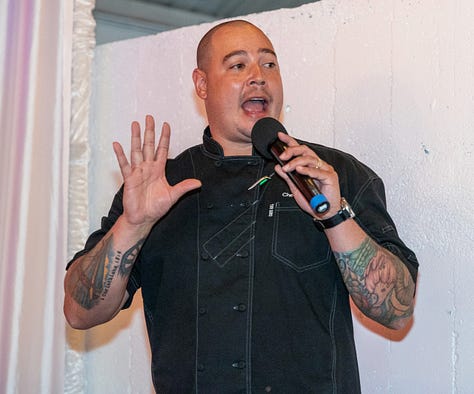

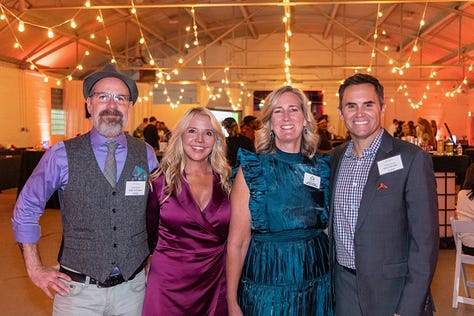





I co-judged Homeward Pikes Peak’s inaugural Sober Soirée this past Saturday along with Fox21’s Matt Meister and Gold Hill Mesa’s Stephanie Edwards. Chef Brother Luck co-presented the event and ultimately awards were given out in people’s choice categories for the best bite and best sip. (We judges just provided commentary and were available in case a tie breaker was called for. It wasn’t.) Pub Dog won in the drink category for its mocktail, and MacKenzie’s Chop House earned top audience votes in the bites category. All of us judges and everyone we spoke with was impressed by the high quality of offerings all around. As Matt Meister said: “Everyone brought their A-game.” He’s not wrong.
For my part, I just want to commend HPP and Chef Luck on the bold move to host a dry function. It was a risk when folks everywhere are used to cocktails, wine and beer at just about every town fundraiser that’s not a breakfast. But mocktails are strong in the marketplace these days and many folks have quit drinking simply for health reasons and a lifestyle change. I found the event completely refreshing and just as enjoyable as any booze-laced party around. I loved leaving completely sharp and not sloggy feeling. But mostly I was impressed at how creative the bartending entities got with their drinks to make them special sans real hooch. Many utilized commercial non-alcoholic spirits in their bases, but others relied on ingredients like apple cider vinegar, which fit the fall time perfectly. Wobbly Olive created a gin-and-tonic spin (my and Matt’s favorite) that was so accurate and on-point we gave it a special call-out. I also dug the warehouse venue at 114 W. Cimarron (the Meanwhile Block Barrel Building). Overall: totally impressive for a year-one event especially. Cheers!

